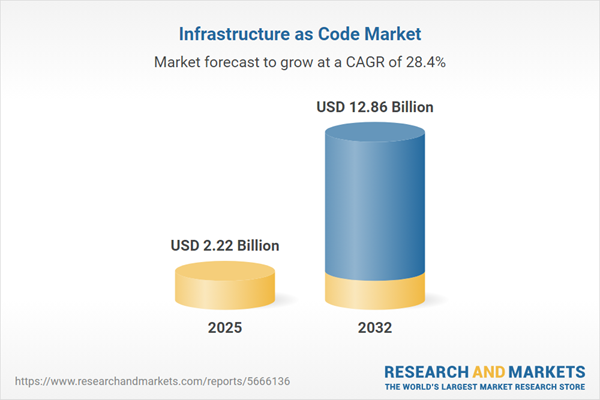Speak directly to the analyst to clarify any post sales queries you may have.
Infrastructure as Code (IaC) is redefining how enterprises automate, manage, and secure modern IT environments. As organizations accelerate cloud adoption and seek operational efficiency, decision-makers are turning to Infrastructure as Code for greater agility, consistency, and control.
Market Snapshot: Infrastructure as Code Market Growth
The Infrastructure as Code market expanded from USD 1.74 billion in 2024 to USD 2.22 billion in 2025, reflecting strong momentum. Projected to register a CAGR of 28.38%, the market is forecast to reach USD 12.86 billion by 2032, signaling broad enterprise adoption and increased investment in automated provisioning.
Scope & Segmentation of the Infrastructure as Code Market
- Offering Types: Services (Managed Services, Professional Services—Consulting, Implementation, Support, Training), Tools (Commercial Tools, Open Source Tools)
- Deployment Models: Cloud (Hybrid Cloud, Private Cloud, Public Cloud), On Premises
- Organization Sizes: Large Enterprises, Small and Medium Enterprises
- Industry Verticals: Banking, Financial Services and Insurance; Government and Defense; Healthcare and Life Sciences; IT and Telecom; Retail and Consumer Goods
- Regional Coverage: Americas (United States, Canada, Mexico, Brazil, Argentina, Chile, Colombia, Peru), Europe, Middle East & Africa (United Kingdom, Germany, France, Russia, Italy, Spain, Netherlands, Sweden, Poland, Switzerland, United Arab Emirates, Saudi Arabia, Qatar, Turkey, Israel, South Africa, Nigeria, Egypt, Kenya), Asia-Pacific (China, India, Japan, Australia, South Korea, Indonesia, Thailand, Malaysia, Singapore, Taiwan)
- Key Companies: Amazon Web Services, Inc.; Microsoft Corporation; Google LLC; HashiCorp, Inc.; Red Hat, Inc.; Puppet, Inc.; Progress Software Corporation; VMware, Inc.; Pulumi Corporation; Oracle Corporation
Key Takeaways for Senior Leaders
- Infrastructure as Code empowers organizations to automate IT provisioning using standardized, repeatable code artifacts, minimizing configuration errors and operating risk.
- The market's evolution is fueled by cloud-native adoption, DevOps integration, and policy as code, which embed governance and security checks into automated workflows.
- Enterprises benefit from modular, parameterized templates that accelerate onboarding and support compliant, scalable environments across development, testing, and production.
- Vendor strategies are shifting toward open ecosystems, blending commercial orchestration platforms with extensible open-source frameworks for greater agility and cost control.
- Distinct regional regulations and infrastructure maturity shape deployment models and technology partner selection, requiring tailored approaches in different international markets.
Tariff Impact on Infrastructure as Code
New tariffs introduced by the United States in 2025 disrupted global supply chains for hardware and software supporting Infrastructure as Code initiatives. Organizations experienced extended lead times and rising costs, prompting a reassessment of hardware refresh cycles and greater reliance on cloud and software-defined alternatives. Vendors responded with adjusted procurement practices, localized support, flexible licensing, and open-source adoption to mitigate price increases and supply risk.
Methodology & Data Sources
Insights in this report are drawn from direct interviews with industry specialists, structured multi-sector surveys, and a thorough review of technical documentation, case studies, and expert commentary. Each finding was validated through independent reviews and cross-checked benchmarks to ensure transparency and credibility.
Why This Report Matters to Decision-Makers
- Enables enterprises to build policy-driven, scalable, and secure Infrastructure as Code strategies tailored to evolving compliance, business, and operational needs.
- Equips stakeholders to address region-specific challenges—including regulatory shifts and supply chain volatility—through actionable segmentation and technology insights.
- Supports informed vendor selection and competitive analysis by detailing key provider strengths, open-source trends, and regional dynamics.
Conclusion
Organizations seeking resilient automation and efficient IT management benefit from embracing Infrastructure as Code as the foundation for scalable, adaptive digital infrastructures. This report delivers the critical analysis and guidance senior leaders need to shape successful adoption strategies in a dynamic market.
Additional Product Information:
- Purchase of this report includes 1 year online access with quarterly updates.
- This report can be updated on request. Please contact our Customer Experience team using the Ask a Question widget on our website.
Table of Contents
3. Executive Summary
4. Market Overview
7. Cumulative Impact of Artificial Intelligence 2025
Companies Mentioned
The companies profiled in this Infrastructure as Code market report include:- Amazon Web Services, Inc.
- Microsoft Corporation
- Google LLC
- HashiCorp, Inc.
- Red Hat, Inc.
- Puppet, Inc.
- Progress Software Corporation
- VMware, Inc.
- Pulumi Corporation
- Oracle Corporation
Table Information
| Report Attribute | Details |
|---|---|
| No. of Pages | 187 |
| Published | November 2025 |
| Forecast Period | 2025 - 2032 |
| Estimated Market Value ( USD | $ 2.22 Billion |
| Forecasted Market Value ( USD | $ 12.86 Billion |
| Compound Annual Growth Rate | 28.3% |
| Regions Covered | Global |
| No. of Companies Mentioned | 11 |









